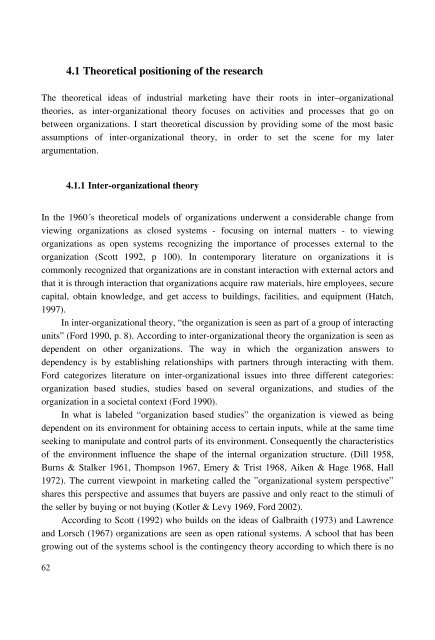Value Co-Creation in Industrial Buyer-Seller Partnerships ... - Doria
Value Co-Creation in Industrial Buyer-Seller Partnerships ... - Doria
Value Co-Creation in Industrial Buyer-Seller Partnerships ... - Doria
- No tags were found...
Create successful ePaper yourself
Turn your PDF publications into a flip-book with our unique Google optimized e-Paper software.
4.1 Theoretical position<strong>in</strong>g of the researchThe theoretical ideas of <strong>in</strong>dustrial market<strong>in</strong>g have their roots <strong>in</strong> <strong>in</strong>ter–organizationaltheories, as <strong>in</strong>ter-organizational theory focuses on activities and processes that go onbetween organizations. I start theoretical discussion by provid<strong>in</strong>g some of the most basicassumptions of <strong>in</strong>ter-organizational theory, <strong>in</strong> order to set the scene for my laterargumentation.4.1.1 Inter-organizational theoryIn the 1960 ś theoretical models of organizations underwent a considerable change fromview<strong>in</strong>g organizations as closed systems - focus<strong>in</strong>g on <strong>in</strong>ternal matters - to view<strong>in</strong>gorganizations as open systems recogniz<strong>in</strong>g the importance of processes external to theorganization (Scott 1992, p 100). In contemporary literature on organizations it iscommonly recognized that organizations are <strong>in</strong> constant <strong>in</strong>teraction with external actors andthat it is through <strong>in</strong>teraction that organizations acquire raw materials, hire employees, securecapital, obta<strong>in</strong> knowledge, and get access to build<strong>in</strong>gs, facilities, and equipment (Hatch,1997).In <strong>in</strong>ter-organizational theory, “ the organization is seen as part of a group of <strong>in</strong>teract<strong>in</strong>gunits” (Ford 1990, p. 8). Accord<strong>in</strong>g to <strong>in</strong>ter-organizational theory the organization is seen asdependent on other organizations. The way <strong>in</strong> which the organization answers todependency is by establish<strong>in</strong>g relationships with partners through <strong>in</strong>teract<strong>in</strong>g with them.Ford categorizes literature on <strong>in</strong>ter-organizational issues <strong>in</strong>to three different categories:organization based studies, studies based on several organizations, and studies of theorganization <strong>in</strong> a societal context (Ford 1990).In what is labeled “ organization based studies” the organization is viewed as be<strong>in</strong>gdependent on its environment for obta<strong>in</strong><strong>in</strong>g access to certa<strong>in</strong> <strong>in</strong>puts, while at the same timeseek<strong>in</strong>g to manipulate and control parts of its environment. <strong>Co</strong>nsequently the characteristicsof the environment <strong>in</strong>fluence the shape of the <strong>in</strong>ternal organization structure. (Dill 1958,Burns & Stalker 1961, Thompson 1967, Emery & Trist 1968, Aiken & Hage 1968, Hall1972). The current viewpo<strong>in</strong>t <strong>in</strong> market<strong>in</strong>g called the ” organizational system perspective”shares this perspective and assumes that buyers are passive and only react to the stimuli ofthe seller by buy<strong>in</strong>g or not buy<strong>in</strong>g (Kotler & Levy 1969, Ford 2002).Accord<strong>in</strong>g to Scott (1992) who builds on the ideas of Galbraith (1973) and Lawrenceand Lorsch (1967) organizations are seen as open rational systems. A school that has beengrow<strong>in</strong>g out of the systems school is the cont<strong>in</strong>gency theory accord<strong>in</strong>g to which there is no62
















